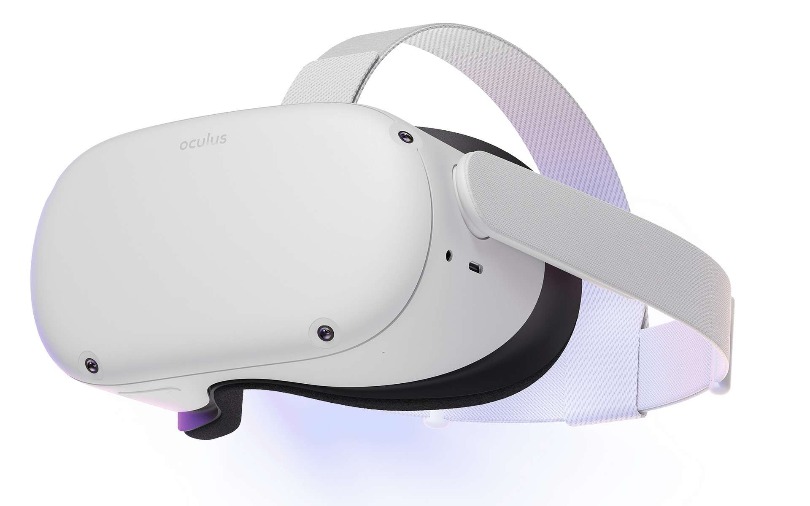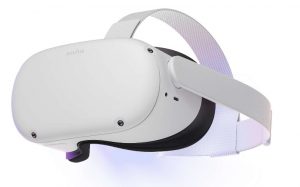Review of the Oculus Rift vs HTC Vive
This is a detailed review of the Oculus Rift vs the HTC Vive, the best virtual reality headsets available right now. Both devices offer an immersive experience and provide gamers with a wide range of features. This guide aims to help buyers choose the perfect headset based on their preferences.

Review of the Oculus Rift vs HTC Vive. First thing I want to mention is that this article isn’t sponsored or endorsed by any company. It is purely a review of the Oculus Rift and HTC Vive.
1) The History of VR
The VR industry has come a long way since its humble beginnings in the 1990s when computer technology was still very primitive. However, it wasn’t until 2012 that the Oculus Rift hit the market, and in 2015 both Sony’s Project Morpheus and Valve’s SteamVR made headlines as well.
The year 2016 saw the release of several high-quality products such as Samsung Gear VR, Google Cardboard, Razer Hydra, and many more. It also brought about some significant changes in the world of VR – from game releases to hardware upgrades and price drops. Let’s take a look at how these headsets have evolved over time, and which one offers better value for money today.
The history of virtual reality starts back in 1963 when Ivan Sutherland created his “Head-On” system. The concept consisted of two video cameras attached to helmets worn by users, allowing them to see themselves in 3D while interacting with a computer generated environment.
Later on, Palmer Luckey started tinkering with the idea of building a low cost virtual reality device. He eventually came up with the Rift prototype after getting inspired by a sci-fi novel he read titled Snow Crash written by Neal Stephenson. Although there were other attempts before him, the Rift became the first commercially successful consumer product of this type.
Released in March 2016, it sold out within minutes of being released. Its initial $599 price tag quickly dropped down to around $399 due to strong demand.
There are numerous VR headsets available on the market today. Most people refer to all of them as VR Headsets or Virtual Reality Headset (or VR HMD) because they all work on similar principles. In order to understand what makes each one unique, let’s compare their key features.
1. Design
The design of the VR headset varies depending on the manufacturer. For example, you can find Rift headsets designed to be used with only your eyes or head, but not your hands, while others feature hand controllers. You may even come across those that require the use of headphones too. Some companies prefer using elastic bands instead of straps, while others go for leather padding.
When it comes to color options, you’ll mostly find black, white, blue, green, red, orange, and gray models. There are also limited edition models made to match certain outfits or games.
2. Sensors
Each headset uses different sensors. To begin with, Oculus Rift uses an infrared sensor placed on top of the headset itself. These sensors measure the movement of the user’s head, allowing it to move objects in real life in the virtual world. On the other hand, HTC Vive requires two motion trackers located in front of the player’s body, while PlayStation VR relies on an external camera to capture movements.
3. Display Resolution
Oculus Rift and HTC Vive display images in 1080p, which is fine for most applications. Meanwhile, PlayStation VR displays 2160 x 1200 pixels. All of these devices support stereoscopic 3D technology, which means they allow users to view multiple views simultaneously. Some manufacturers like HTC and Sony add extra depth by adding special lenses, so users get a full 360 degree field of vision.
4. Cost
Both the Rift and Vive are expensive, although they’re quite affordable if compared to the latest generation consoles. Oculus Rift costs around $400, whereas the Vive goes for approximately $600. While both devices have a lot of great features, the Rift lacks the number of third party accessories that the Vive offers.
The latter is more versatile and allows users to enjoy a wider variety of VR experiences. Furthermore, it supports room scale gaming, where players have freedom of movement. The Vive has been optimized for first person shooters, but the Rift is capable of handling all kinds of games.
5. Software
While both platforms are compatible with a huge selection of games, they differ significantly when it comes to quality. Sony’s PlayStation VR platform is home to excellent titles such as Superhot VR, Farpoint, and RIGS Mechanized Combat League. On the other hand, Oculus Rift doesn’t offer much in terms of exclusive content and tends to focus on indie developers who release experimental projects.
6. Battery Life
It should be noted that the battery life depends on the VR application in question. However, HTC Vive and Oculus Rift last for about three hours on average.
7. Connectivity
Since both the Vive and Rift rely on wireless technologies, there’s no need to connect any wires to a PC. Moreover, both devices have built-in microphones that make communication easier. They can also detect the position of your hands, allowing you to interact with virtual objects and controls.
8. Games
Sony’s PlayStation VR has a large library of VR games, thanks to the fact that it works exclusively with PlayStation 4 consoles. As far as Oculus Rift and HTC Vive are concerned, there are plenty of titles to play, including classics such as Doom, Skyrim, Batman Arkham VR, etc. The good news is that the Rift is currently working on a version of Minecraft specifically designed for VR.
9. Motion Controllers
HTC and Oculus VR have taken a slightly different approach when it comes to motion controllers. Whereas the former opts for hand-held controllers, the latter prefers using its own line of Touch controllers.
Both types of controllers have their pros and cons, and it’s important to remember that each one is designed for specific VR applications. In short, Oculus Rift and Vive allow players to explore the virtual world using a set of handheld controllers. On the other hand, PSVR uses a stationary controller that’s positioned in front of the player.
10. Compatibility
All major VR headsets work with PCs that run Windows 7 or newer versions of the operating system. They’re compatible with NVIDIA GeForce GTX 970M graphics cards or higher, while the HTC Vive requires a powerful PC. Oculus Rift runs on computers running Intel i5 or AMD FX 8350 processors, as well as a 1 TB hard drive.
11. Performance
There are a few differences between the performance offered by these headsets. Oculus Rift offers smooth visuals, but it’s not capable of displaying ultra high definition resolutions. On the other hand, HTC Vive boasts impressive resolution and can render graphics with astonishing accuracy.
12. Head Tracking
As mentioned earlier, both the Rift and Vive use optical tracking systems that can track your head movements without any noticeable lag. They also support head gestures, which can be used to control menus and actions in virtual environments.
13. Comfort
In general, Oculus Rift is lighter than the Vive, and its design makes it more comfortable to wear. This might sound odd at first, but we have to keep in mind that the headset has no straps. Instead, it relies on an elastic band that holds everything together. If you don’t want the strap to slip off your head, you can adjust it to fit your needs.
14. Resolution
Both the Rift and Vive deliver crisp images, especially when viewed through a monitor. But if you decide to upgrade to a new headset, you’ll notice a difference in the overall image quality. The Rift displays sharper text and icons, while the Vive provides a more natural feel to images. However, neither of these headsets looks bad on HD screens.
15. Price
Compared to their rivals, the Rift and Vive are priced quite reasonably. They are also a bit cheaper than PlayStation VR, although Sony’s headset has more advanced technology. However, you shouldn’t expect them to drop in price anytime soon.
16. Warranty
The Rift and Vive are covered by a one year warranty. That’s not enough to protect your purchase from accidental damage, but it does give you some peace of mind. On the other hand, Sony offers a limited lifetime guarantee for PlayStation VR headsets.
17. Size
Oculus Rift and HTC Vive are compact, lightweight devices that can easily be carried around in a bag. They weigh less than 400 grams combined, which makes them easy to transport. The latter weighs 300 grams alone, which is ideal for traveling. Sony’s solution is heavier, weighing 600 grams. However, the company sells separate carrying cases to prevent the device from falling apart.
18. Audio
Oculus Rift is equipped with integrated speakers that produce clear sounds, even at high volumes. The Vive doesn’t have any audio output, but there are third party solutions such as VIVE Pro Wireless Stereo Headset or the XIM3D Smart Earphones that will improve the experience considerably.
2) Oculus Rift vs HTC Vive
If you’ve ever tried a VR headset before, then you probably already know that there are two main competitors in this category – Oculus Rift and HTC Vive. Each one comes with its own unique features, but they also share many similarities. In order to help you decide which one suits you better, let’s take a closer look at their specs and design elements.
1) Hardware
First of all, we’d like to point out that both headsets use high-end components that ensure exceptional visual and audio quality.
One thing that sets them apart from other headsets is that they don’t use bulky cables that would normally interfere with gameplay. In addition, each one comes with a wireless adapter that lets users walk around freely. This makes it possible to take advantage of room scale VR without worrying about tripping over the cable or accidentally knocking something over.
Both headsets are equipped with high-quality sensors that enable them to detect the position of your head accurately. Their controllers are also quite unique because they allow users to manipulate objects in 3D space with ease. We have to mention that they lack buttons though, but they’re perfectly capable of performing various functions in VR applications.
However, there are a couple of drawbacks worth mentioning here. First of all, both devices suffer from a short battery life. Even if you use them regularly, you won’t be able to spend more than three hours playing your favorite game before having to recharge. Secondly, they are pretty heavy, which may become uncomfortable after extended periods of time.
2) Display Resolution
Both headsets boast a 1080p display resolution, but there are slight differences between them. The Rift displays a sharper image, while the Vive looks more natural. Another important factor is refresh rate.
The Rift offers a 75 Hz refresh rate, while the Vive offers 90 Hz. As far as motion blur is concerned, the Rift delivers an average level of smoothness, but the Vive is noticeably smoother. On the other hand, it seems that both devices are equally effective when it comes to blocking out light and reducing eye strain.
3) Cost
When it comes to cost, both headsets are relatively affordable. The Rift retails for $400, whereas the Vive goes for approximately $600. It’s worth noting that the Rift requires an expensive computer in order to operate properly, while the Vive is compatible with most modern gaming rigs.
4) Compatibility
Both the Rift and the Vive support most recent generation computers and smartphones, although they require a minimum of a GTX 970 graphics card or higher. In addition, they support wireless adapters and USB ports, so you can play without connecting any wires.
5) Software
When it comes to software, Oculus Rift and HTC Vive have similar applications. However, there’s a significant difference in terms of exclusives. The Rift is home to excellent titles such as Superhot VR, Farpoint, and RIGS Mechanized Combat League. On the other hand, the Vive has a larger library of games, including classics such as Doom, Skyrim, Batman Arkham VR, etc.
6) Battery Life
Both headsets have very poor battery lives that don’t last longer than three hours. However, Oculus Rift is more energy efficient since it uses a built-in sensor that keeps the headset powered down until it detects your presence. On the other hand, the Vive has a wired connection that requires frequent charging.
7) Connectivity
Connecting these headsets to a PC is simple and straightforward. They both feature wireless technologies that make setup easier. The Rift has built-in wireless connectivity, while the Vive relies on third party solutions such as VIVE Pro Wireless Stereo Headset.
8) Conclusion
In conclusion, both the Rift and Vive offer incredible experiences and come with plenty of interesting features. They’re suitable for all types of players, regardless of their skill level. However, the Vive wins in terms of compatibility and customization options, which means that you’ll be able to create an environment that suits your individual needs. Furthermore, it’s compatible with more hardware, making it a great choice for people who want to invest in multiple VR devices.
9) Summary
Both the Rift and the Vive have their own pros and cons, and there’s no denying that they complement each other rather well. In fact, it’s hard to pick just one, especially since each one has its own unique set of advantages. As long as you’re willing to spend money on VR accessories, you’ll be able to enjoy top-notch entertainment that brings you into a whole new world.

Virtual Reality (VR) is becoming more and more popular every day, and many manufacturers are releasing VR headsets that aim to transform our everyday lives. Some of these devices are designed specifically for gamers, while others are meant to appeal to casual users who want to experience virtual worlds without spending too much money.






This is a really helpful comparison! Thanks for putting it together.
I think that both the Rift and the Vive have their own advantages. While the Vive offers a wider variety of games, the Rift seems more reliable in terms of comfort. Also, it’s way cheaper than the Vive. Still, I’d go for the Vive simply because it’s more convenient. After all, it’s easier to get rid of an old computer than to find another VR headset that works with your current machine.
I’m really glad I found this site. It helped me decide which VR headset to buy. I had no idea that the Rift wasn’t compatible with all computers. That would have been a deal breaker for me.